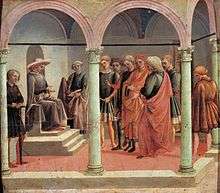Francesco Pesellino

Francesco Pesellino (probably 1422-July 29, 1457), also known as Francesco di Stefano, Il Pesellino, Francesco Peselli, and Francesco di Stefano Pesellino was an Italian (Florentine) painter. His father was the painter Stefano di Francesco (died 1427), and his maternal grandfather was the painter Giuliano Pesello (1367–1446), from whose name the diminutive nickname of "Pesellino" arose. After the death of his father in 1427, the young Francesco Pesellino went to live with his grandfather, Giuliano Pesello, adopting his name. Francesco Pesellino remained in his grandfather’s studio until the latter’s death, when he joined the studio of Filippo Lippi (ca.1406-1469). He married in 1442, and probably joined the Florence painters' guild in 1447. In the following years he made a reputation with small, highly finished, works, either religious subjects for predellas or private devotions, or secular subjects, often for insetting into furniture or panelling.
Pesellino died in Florence in 1457, at only 35, cutting short a career with great promise. His style "anticipates the developments of later Florentine painters such as Verrocchio and the Pollaiuoli".[1]
Works

According to Vasari, he painted the predella scenes to an altarpiece by Lippi for Santa Croce; these are now divided between the Uffizi, Louvre, and Bergamo. His only surviving securely documented work, and his only recorded large-scale work, is an altarpiece with predella of the Trinity (National Gallery, London), which was only half complete at his death, and was finished by Filippo Lippi and his workshop. The main panel, nearly square at over 1.8m in each dimension, shows the Trinity in the Throne of Mercy motif, flanked by four standing saints, and angels. One predella panel is in the Hermitage, St Petersburg. The commission is unusually well documented, to which records of the litigation between Pesellino's widow and his business partner over the money due for the incomplete work can be added, and the records are much cited by art historians. The work was first decided upon in 1455 by the commissioners, the confraternity of priests at Pistoia, and they did not finally receive it until 1460. Drawings for the work also survive. The altarpiece was later cut up into six parts, probably in the eighteenth century, and has now been reassembled, with one section reconstructed, and another on loan from the Royal Collection.[2]
A number of other paintings, now lost, hung in prominent positions in the Palazzo Medici and the Medici Casa Vecchia, and at least one work by Pesellino hung in the same room as Paolo Uccello's Battle of San Romano. Some surviving panel paintings have been identified as his by stylistic comparison with the altarpiece, including two long horizontal panels with the Story of David and Goliath and the Triumph of David, probably from cassoni (also National Gallery, London).[3] Other cassoni pieces are in and Bergamo and Boston, whilst the Metropolitan Museum of Art and Toledo, Ohio have other works. A small diptych of the Annunciation in the Courtauld Institute is a good example of the cabinet paintings that made his reputation. The Hermitage also has six very beautiful full-page miniatures from an illuminated manuscript.
Notes
References
- National Gallery Catalogues (new series): The Fifteenth Century Italian Paintings, Volume 1, by Dillian Gordon, 2003, ISBN 1-85709-293-7
- Vasari, Giorgio, Le Vite delle più eccellenti pittori, scultori, ed architettori, many editions and translations.
- Sheridan, Victoria, Inventing Pesellino: Biography, Language and Style in Art History, M.A. Thesis (2003), University of California, Davis. OCLC#55762857
External links
| Wikimedia Commons has media related to Francesco di Stefano Pesellino. |
- National Gallery
- Boston cassoni panels
- Artcyclopedia links
- Italian Paintings: Florentine School, a collection catalog containing information about Pesellino and his works (see Pesellino, pages: 95-98).